2003 NISSAN FRONTIER lock
[x] Cancel search: lockPage 8 of 272
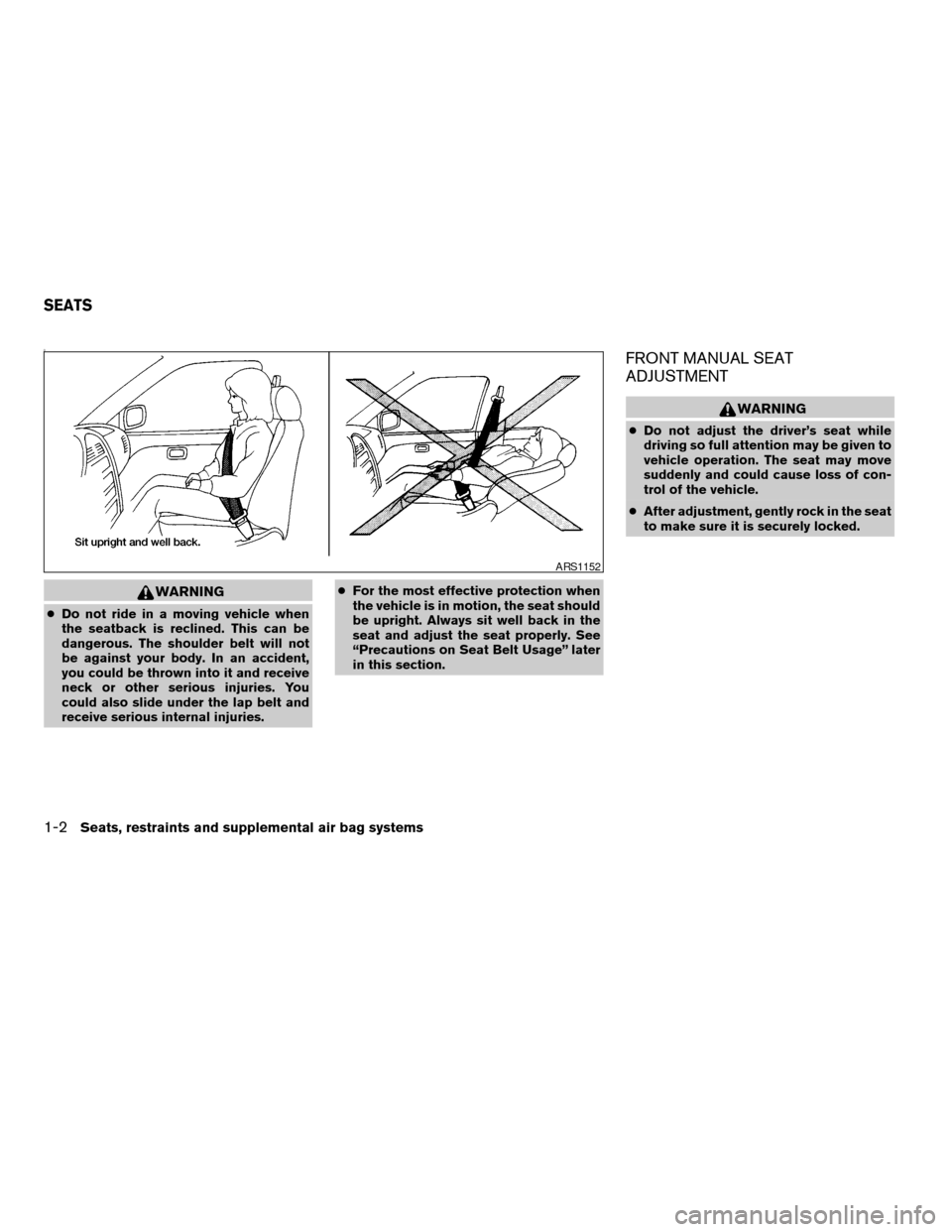
0
WARNING
cDo not ride in a moving vehicle when
the seatback is reclined. This can be
dangerous. The shoulder belt will not
be against your body. In an accident,
you could be thrown into it and receive
neck or other serious injuries. You
could also slide under the lap belt and
receive serious internal injuries.cFor the most effective protection when
the vehicle is in motion, the seat should
be upright. Always sit well back in the
seat and adjust the seat properly. See
“Precautions on Seat Belt Usage” later
in this section.
FRONT MANUAL SEAT
ADJUSTMENT
WARNING
cDo not adjust the driver’s seat while
driving so full attention may be given to
vehicle operation. The seat may move
suddenly and could cause loss of con-
trol of the vehicle.
cAfter adjustment, gently rock in the seat
to make sure it is securely locked.
ARS1152
SEATS
1-2Seats, restraints and supplemental air bag systems
ZREVIEW COPY:Ð2003 Truck/Frontier(d22)
Owners Manual(owners)ÐUSA English(nna)
01/13/03Ðarosenma
X
Page 9 of 272
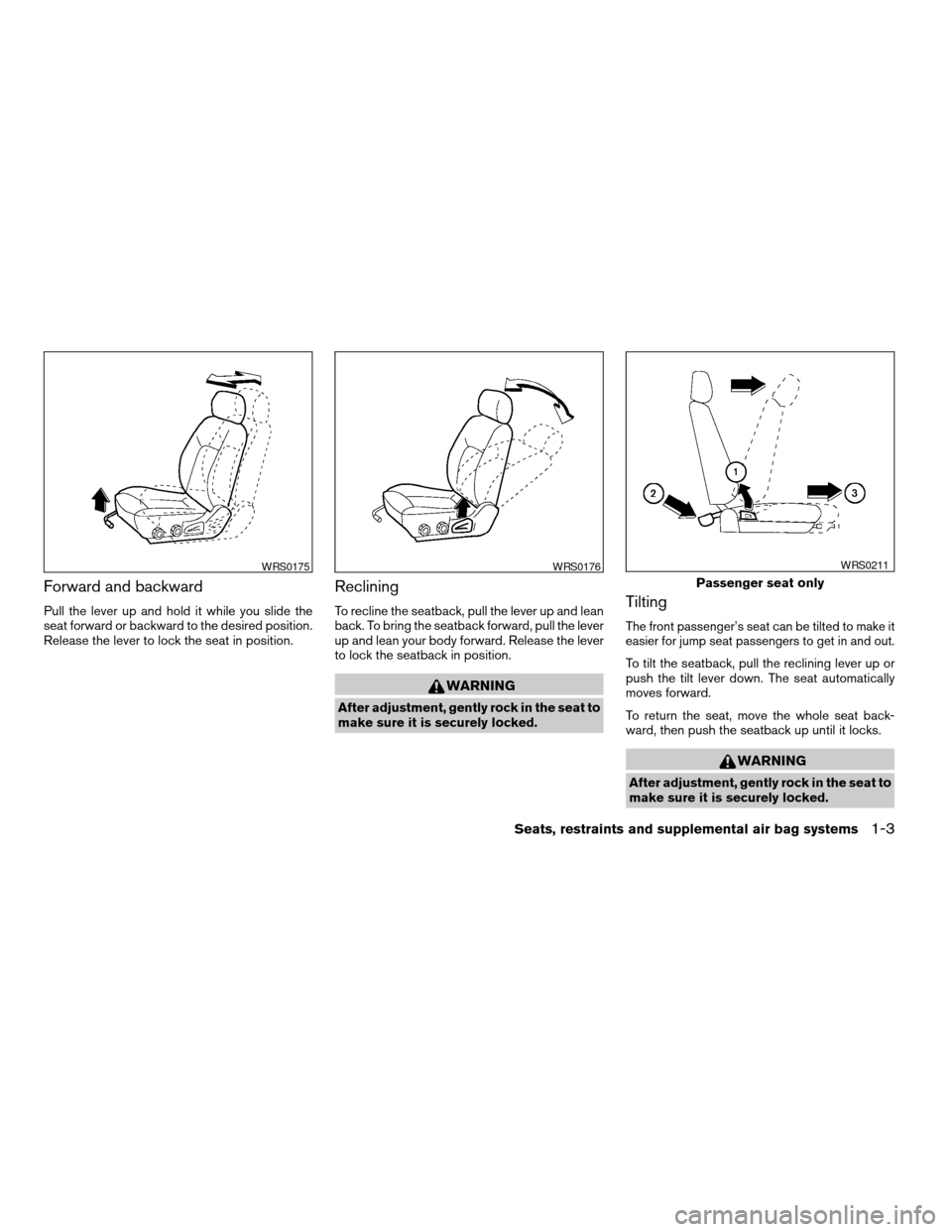
Forward and backward
Pull the lever up and hold it while you slide the
seat forward or backward to the desired position.
Release the lever to lock the seat in position.
Reclining
To recline the seatback, pull the lever up and lean
back. To bring the seatback forward, pull the lever
up and lean your body forward. Release the lever
to lock the seatback in position.
WARNING
After adjustment, gently rock in the seat to
make sure it is securely locked.
Tilting
The front passenger’s seat can be tilted to make it
easier for jump seat passengers to get in and out.
To tilt the seatback, pull the reclining lever up or
push the tilt lever down. The seat automatically
moves forward.
To return the seat, move the whole seat back-
ward, then push the seatback up until it locks.
WARNING
After adjustment, gently rock in the seat to
make sure it is securely locked.
WRS0175WRS0176
Passenger seat only
WRS0211
Seats, restraints and supplemental air bag systems1-3
ZREVIEW COPY:Ð2003 Truck/Frontier(d22)
Owners Manual(owners)ÐUSA English(nna)
01/13/03Ðarosenma
X
Page 11 of 272
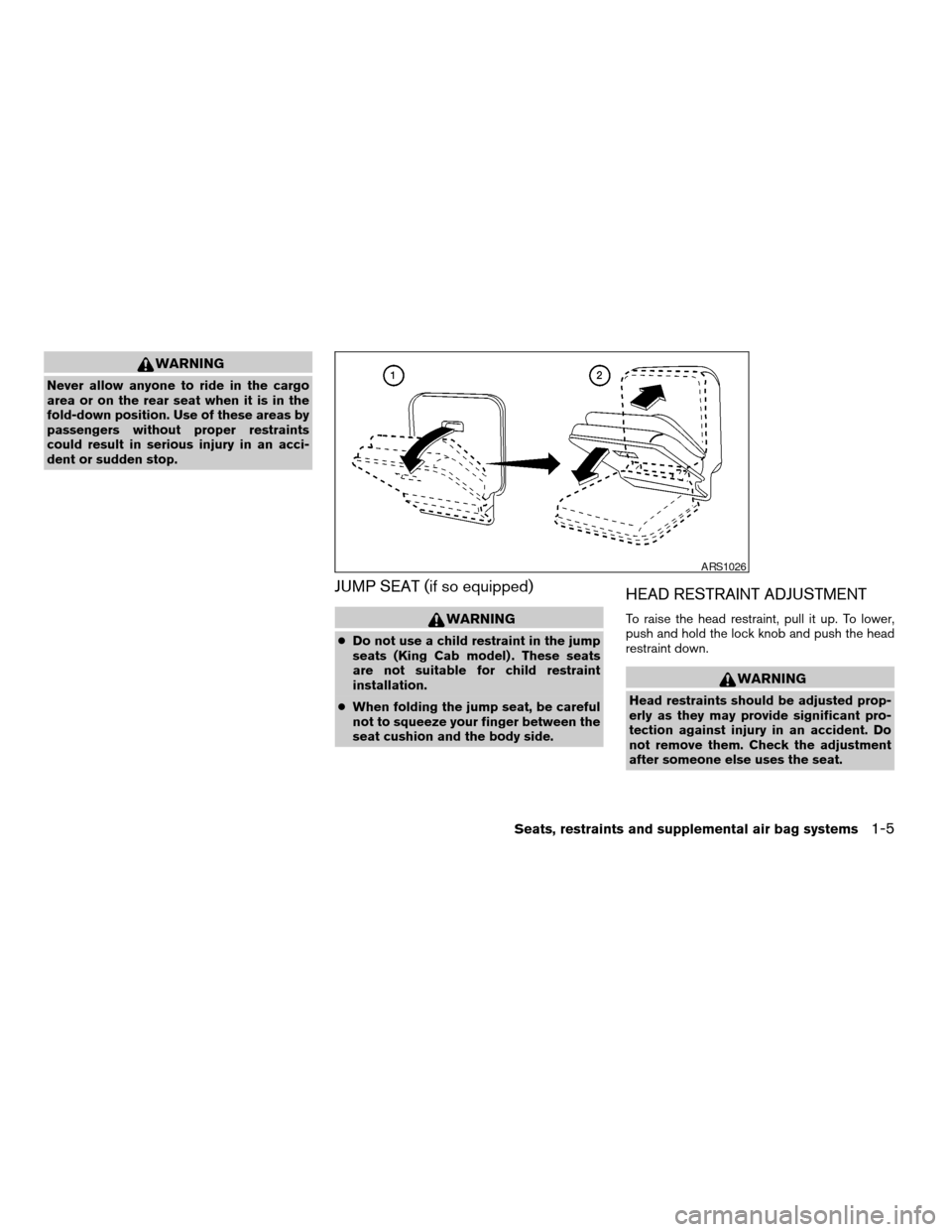
WARNING
Never allow anyone to ride in the cargo
area or on the rear seat when it is in the
fold-down position. Use of these areas by
passengers without proper restraints
could result in serious injury in an acci-
dent or sudden stop.
JUMP SEAT (if so equipped)
WARNING
cDo not use a child restraint in the jump
seats (King Cab model) . These seats
are not suitable for child restraint
installation.
cWhen folding the jump seat, be careful
not to squeeze your finger between the
seat cushion and the body side.
HEAD RESTRAINT ADJUSTMENT
To raise the head restraint, pull it up. To lower,
push and hold the lock knob and push the head
restraint down.
WARNING
Head restraints should be adjusted prop-
erly as they may provide significant pro-
tection against injury in an accident. Do
not remove them. Check the adjustment
after someone else uses the seat.
ARS1026
Seats, restraints and supplemental air bag systems1-5
ZREVIEW COPY:Ð2003 Truck/Frontier(d22)
Owners Manual(owners)ÐUSA English(nna)
01/13/03Ðarosenma
X
Page 21 of 272
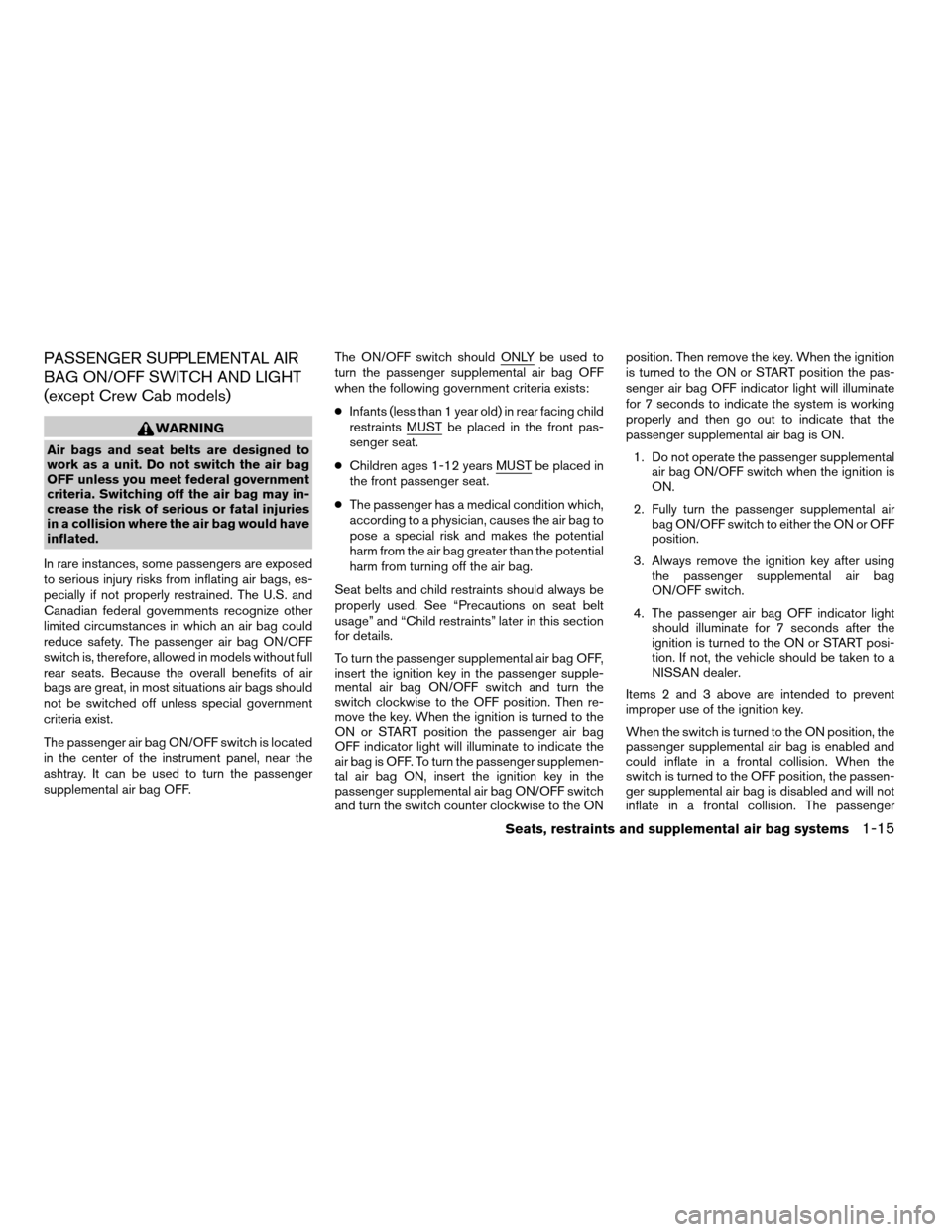
PASSENGER SUPPLEMENTAL AIR
BAG ON/OFF SWITCH AND LIGHT
(except Crew Cab models)
WARNING
Air bags and seat belts are designed to
work as a unit. Do not switch the air bag
OFF unless you meet federal government
criteria. Switching off the air bag may in-
crease the risk of serious or fatal injuries
in a collision where the air bag would have
inflated.
In rare instances, some passengers are exposed
to serious injury risks from inflating air bags, es-
pecially if not properly restrained. The U.S. and
Canadian federal governments recognize other
limited circumstances in which an air bag could
reduce safety. The passenger air bag ON/OFF
switch is, therefore, allowed in models without full
rear seats. Because the overall benefits of air
bags are great, in most situations air bags should
not be switched off unless special government
criteria exist.
The passenger air bag ON/OFF switch is located
in the center of the instrument panel, near the
ashtray. It can be used to turn the passenger
supplemental air bag OFF.The ON/OFF switch should ONLY be used to
turn the passenger supplemental air bag OFF
when the following government criteria exists:
cInfants (less than 1 year old) in rear facing child
restraints MUST be placed in the front pas-
senger seat.
cChildren ages 1-12 years MUST be placed in
the front passenger seat.
cThe passenger has a medical condition which,
according to a physician, causes the air bag to
pose a special risk and makes the potential
harm from the air bag greater than the potential
harm from turning off the air bag.
Seat belts and child restraints should always be
properly used. See “Precautions on seat belt
usage” and “Child restraints” later in this section
for details.
To turn the passenger supplemental air bag OFF,
insert the ignition key in the passenger supple-
mental air bag ON/OFF switch and turn the
switch clockwise to the OFF position. Then re-
move the key. When the ignition is turned to the
ON or START position the passenger air bag
OFF indicator light will illuminate to indicate the
air bag is OFF. To turn the passenger supplemen-
tal air bag ON, insert the ignition key in the
passenger supplemental air bag ON/OFF switch
and turn the switch counter clockwise to the ONposition. Then remove the key. When the ignition
is turned to the ON or START position the pas-
senger air bag OFF indicator light will illuminate
for 7 seconds to indicate the system is working
properly and then go out to indicate that the
passenger supplemental air bag is ON.
1. Do not operate the passenger supplemental
air bag ON/OFF switch when the ignition is
ON.
2. Fully turn the passenger supplemental air
bag ON/OFF switch to either the ON or OFF
position.
3. Always remove the ignition key after using
the passenger supplemental air bag
ON/OFF switch.
4. The passenger air bag OFF indicator light
should illuminate for 7 seconds after the
ignition is turned to the ON or START posi-
tion. If not, the vehicle should be taken to a
NISSAN dealer.
Items 2 and 3 above are intended to prevent
improper use of the ignition key.
When the switch is turned to the ON position, the
passenger supplemental air bag is enabled and
could inflate in a frontal collision. When the
switch is turned to the OFF position, the passen-
ger supplemental air bag is disabled and will not
inflate in a frontal collision. The passenger
Seats, restraints and supplemental air bag systems1-15
ZREVIEW COPY:Ð2003 Truck/Frontier(d22)
Owners Manual(owners)ÐUSA English(nna)
01/13/03Ðarosenma
X
Page 24 of 272
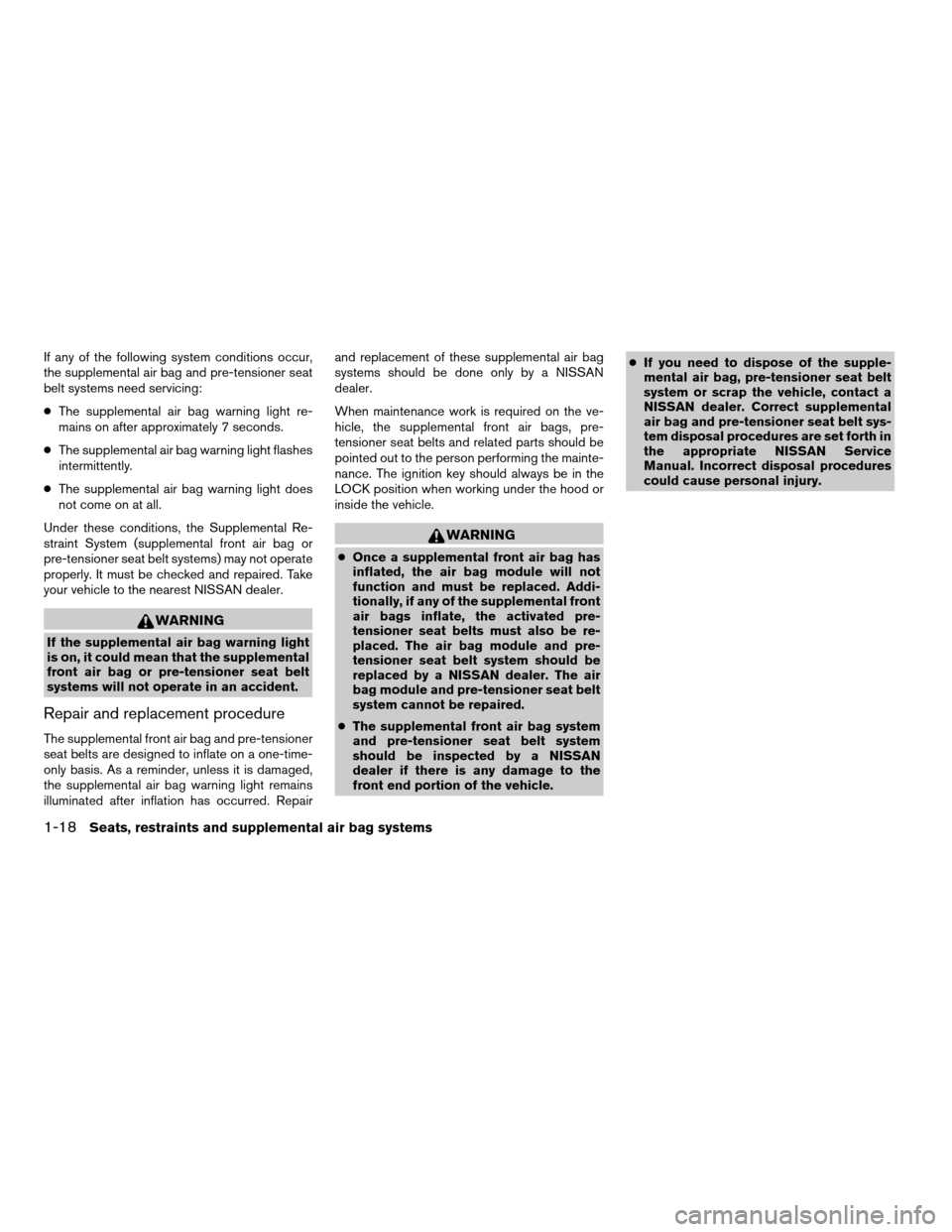
If any of the following system conditions occur,
the supplemental air bag and pre-tensioner seat
belt systems need servicing:
cThe supplemental air bag warning light re-
mains on after approximately 7 seconds.
cThe supplemental air bag warning light flashes
intermittently.
cThe supplemental air bag warning light does
not come on at all.
Under these conditions, the Supplemental Re-
straint System (supplemental front air bag or
pre-tensioner seat belt systems) may not operate
properly. It must be checked and repaired. Take
your vehicle to the nearest NISSAN dealer.
WARNING
If the supplemental air bag warning light
is on, it could mean that the supplemental
front air bag or pre-tensioner seat belt
systems will not operate in an accident.
Repair and replacement procedure
The supplemental front air bag and pre-tensioner
seat belts are designed to inflate on a one-time-
only basis. As a reminder, unless it is damaged,
the supplemental air bag warning light remains
illuminated after inflation has occurred. Repairand replacement of these supplemental air bag
systems should be done only by a NISSAN
dealer.
When maintenance work is required on the ve-
hicle, the supplemental front air bags, pre-
tensioner seat belts and related parts should be
pointed out to the person performing the mainte-
nance. The ignition key should always be in the
LOCK position when working under the hood or
inside the vehicle.
WARNING
cOnce a supplemental front air bag has
inflated, the air bag module will not
function and must be replaced. Addi-
tionally, if any of the supplemental front
air bags inflate, the activated pre-
tensioner seat belts must also be re-
placed. The air bag module and pre-
tensioner seat belt system should be
replaced by a NISSAN dealer. The air
bag module and pre-tensioner seat belt
system cannot be repaired.
cThe supplemental front air bag system
and pre-tensioner seat belt system
should be inspected by a NISSAN
dealer if there is any damage to the
front end portion of the vehicle.cIf you need to dispose of the supple-
mental air bag, pre-tensioner seat belt
system or scrap the vehicle, contact a
NISSAN dealer. Correct supplemental
air bag and pre-tensioner seat belt sys-
tem disposal procedures are set forth in
the appropriate NISSAN Service
Manual. Incorrect disposal procedures
could cause personal injury.
1-18Seats, restraints and supplemental air bag systems
ZREVIEW COPY:Ð2003 Truck/Frontier(d22)
Owners Manual(owners)ÐUSA English(nna)
01/13/03Ðarosenma
X
Page 30 of 272
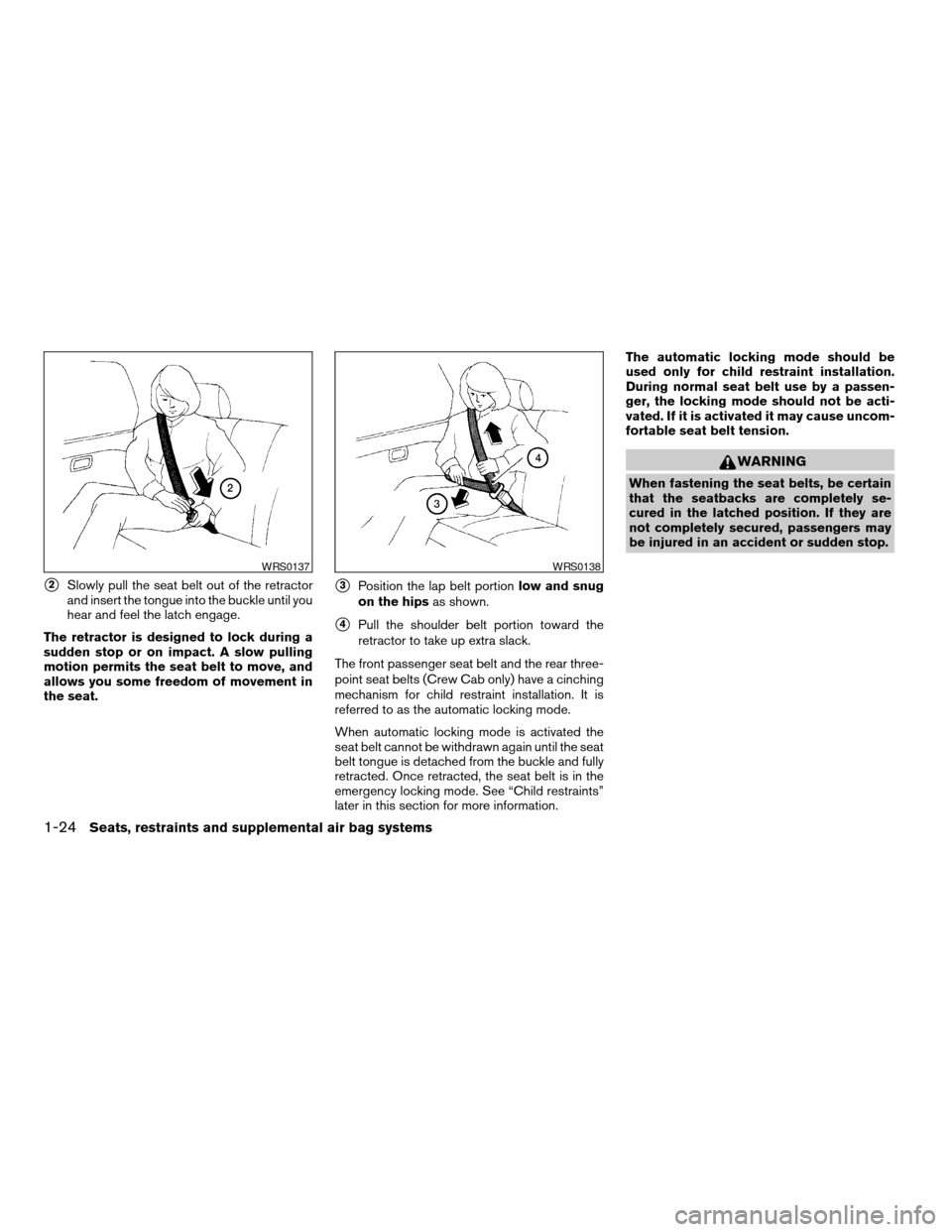
s2Slowly pull the seat belt out of the retractor
and insert the tongue into the buckle until you
hear and feel the latch engage.
The retractor is designed to lock during a
sudden stop or on impact. A slow pulling
motion permits the seat belt to move, and
allows you some freedom of movement in
the seat.s3Position the lap belt portionlow and snug
on the hipsas shown.
s4Pull the shoulder belt portion toward the
retractor to take up extra slack.
The front passenger seat belt and the rear three-
point seat belts (Crew Cab only) have a cinching
mechanism for child restraint installation. It is
referred to as the automatic locking mode.
When automatic locking mode is activated the
seat belt cannot be withdrawn again until the seat
belt tongue is detached from the buckle and fully
retracted. Once retracted, the seat belt is in the
emergency locking mode. See “Child restraints”
later in this section for more information.The automatic locking mode should be
used only for child restraint installation.
During normal seat belt use by a passen-
ger, the locking mode should not be acti-
vated. If it is activated it may cause uncom-
fortable seat belt tension.
WARNING
When fastening the seat belts, be certain
that the seatbacks are completely se-
cured in the latched position. If they are
not completely secured, passengers may
be injured in an accident or sudden stop.
WRS0137WRS0138
1-24Seats, restraints and supplemental air bag systems
ZREVIEW COPY:Ð2003 Truck/Frontier(d22)
Owners Manual(owners)ÐUSA English(nna)
01/13/03Ðarosenma
X
Page 31 of 272

Unfastening the seat belts
s1To unfasten the seat belt, press the button on
the buckle. The seat belt automatically re-
tracts.
Checking seat belt operation
Seat belt retractors are designed to lock seat belt
movement by two separate methods:
cWhen the seat belt is pulled quickly from the
retractor.
cWhen the vehicle slows down rapidly.
To increase your confidence in the seat belts,
check the operation as follows.cGrasp the shoulder belt and pull forward
quickly. The retractor should lock and restrict
further belt movement.
If the retractor does not lock during this check or
if you have any questions about seat belt opera-
tion, see a NISSAN dealer.
Shoulder belt height adjustment (For
front seats)
The shoulder belt anchor height should be ad-
justed to the position best for you. (See “Precau-
tions on seat belt usage” earlier in this section.)
To adjust, pull out the adjustment button
s1and
move the shoulder belt anchor to the desired
position
s2, so the belt passes over the center of
the shoulder. The belt should be away from your
face and neck, but not falling off your shoulder.
Release the adjustment button to lock the shoul-
der belt anchor into position.
WRS0139WRS0226
Seats, restraints and supplemental air bag systems1-25
ZREVIEW COPY:Ð2003 Truck/Frontier(d22)
Owners Manual(owners)ÐUSA English(nna)
01/13/03Ðarosenma
X
Page 40 of 272
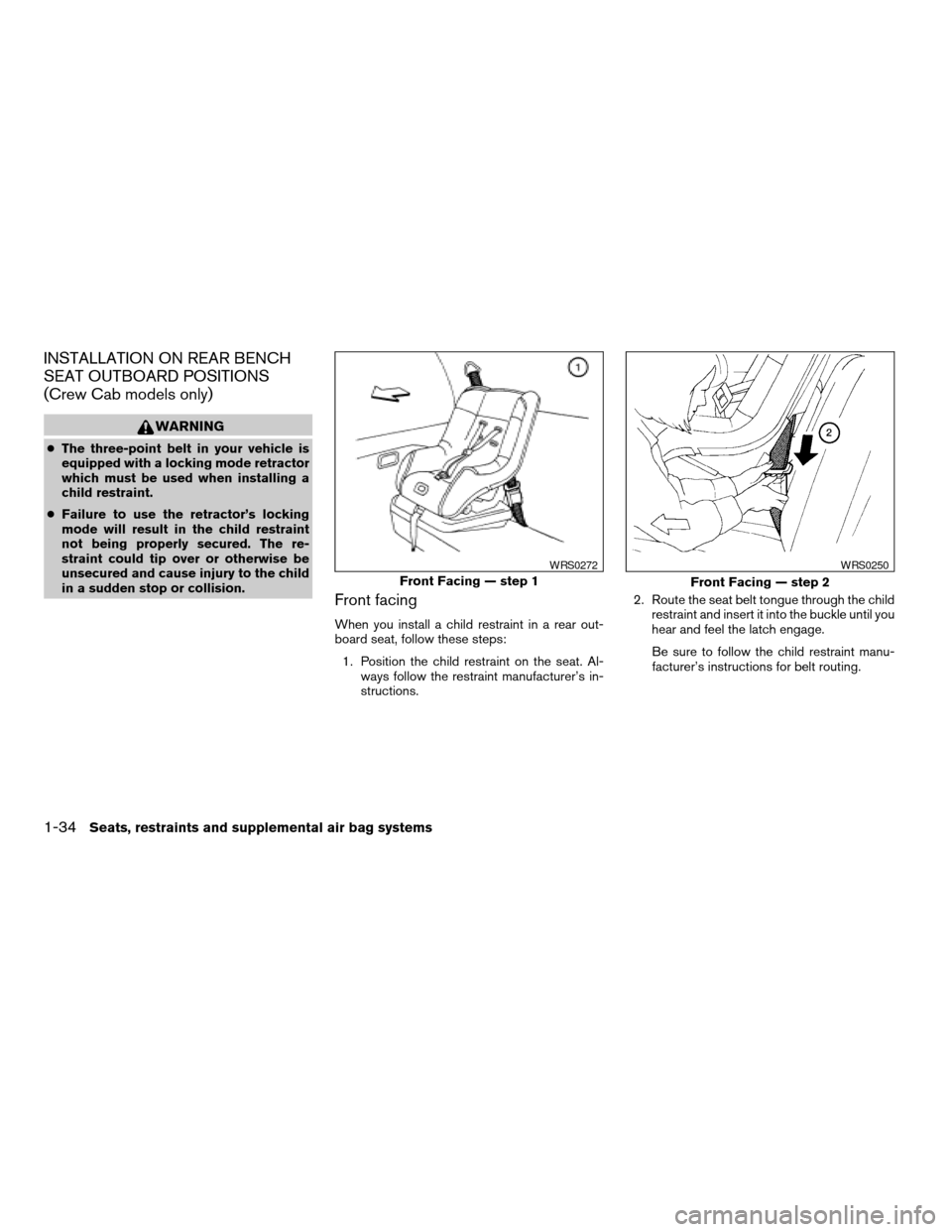
INSTALLATION ON REAR BENCH
SEAT OUTBOARD POSITIONS
(Crew Cab models only)
WARNING
cThe three-point belt in your vehicle is
equipped with a locking mode retractor
which must be used when installing a
child restraint.
cFailure to use the retractor’s locking
mode will result in the child restraint
not being properly secured. The re-
straint could tip over or otherwise be
unsecured and cause injury to the child
in a sudden stop or collision.
Front facing
When you install a child restraint in a rear out-
board seat, follow these steps:
1. Position the child restraint on the seat. Al-
ways follow the restraint manufacturer’s in-
structions.2. Route the seat belt tongue through the child
restraint and insert it into the buckle until you
hear and feel the latch engage.
Be sure to follow the child restraint manu-
facturer’s instructions for belt routing.
Front Facing — step 1
WRS0272
Front Facing — step 2
WRS0250
1-34Seats, restraints and supplemental air bag systems
ZREVIEW COPY:Ð2003 Truck/Frontier(d22)
Owners Manual(owners)ÐUSA English(nna)
01/15/03Ðarosenma
X